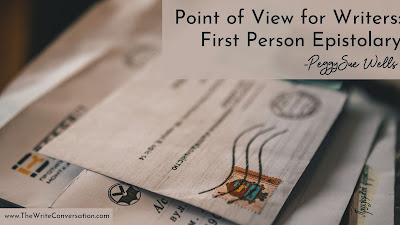Point of View for Writers: First Person Epistolary

by PeggySue Wells @PeggySueWells
Point of view is the issue editors fix most often.
But just how many types of point of view can an author choose from? And why is point of view important?
To excel in the craft, a writer strives to:1. Write excellent, life-changing work2. Tell a compelling story readers can't put down3. Write to a specific audience4. Hone the craft so that your piece is better than everyone else's5. Elicit an emotional response from the reader
POV is a writer’s secret weapon to accomplish these goals. POV is the tool a writer wields to collaborate with and tell the story in the most compelling manner.
Who is the narrator or storyteller? Essentially, there are four categories of point of view. Within those four, a couple have subcategories. All this adds up to a range of options for the writer to consider.First PersonEpistolaryFlashbackCinematicPluralSecond personThird personLimitedObjective OmniscientFourth person
What variations of storytelling does First Person Epistolary POV offer the writer and what does this POV look like?
First Person Epistolary
Characterized by the words I, Me, My, and Mine, First Person Epistolary is a story told through letters, diaries or similar documents.
Penguin’s The Letters of John and Abigail Adams is a good example of this. Abigail asked John to destroy each of her letters after he read them because she was embarrassed with her lack of formal schooling. Though she could read and write, Abigail was aware that much of her spelling was phonetic.
Thankfully, John did not destroy his wife’s letters. The collection of their correspondence across years and continents provides readers with a trusted source of what life was like during the birth of the United States. Additionally, Abigail provides a rare record of what life was like for women of the times.
Likewise, The Book of Abigail and John: Selected Letter of the Adams Family 1762 – 1784 by Butterfield, Friedlaender, and Kline tells the story of the shared life of John and Abigail through the collection of their letters.
“Miss Adorable,” was a common way John addressed Abigail. On October 4, 1762, he wrote “By the same token that bearer hereof sat up with you last night hereby order you to give him as many kisses and as many hours of your company after 9 o’clock as he shall please to demand and charge them to my account.”
Abigail addressed John as My Friend. “If I was sure your absence today was occasioned by what I generally is, either to wait upon company, or promote some good work, I freely confess my mind would be much more at ease than at present it is. Yet this uneasiness does not arise from any apprehension of slight or neglect, but a fear least you are indisposed, for that you said should be your only hinderance.”
Comparing their relationship to Lysander and Diana, she often signed her missives, “from the heart of your sincere Diana.”
Other titles that fall into the category of First Person Epistolary include:
Bridget Jones’s DiaryAnne Frank’s The Diary of a Young GirlThe Color Purple
First Person Options
When considering what POV will prove to be the best narrator for the story, First Person Epistolary is storytelling through letters, diaries, and documents.
This style allows the reader to look over the shoulder of the characters as they share their thoughts and feelings. The reader gleans impressions and insights by picking the obvious and subtle clues in the written entries.
TWEETABLEPoint of View for Writers: First Person Epistolary from @PeggySueWells on @EdieMelson (Click to Tweet)
 PeggySue Wells is the bestselling author of 40 books and collaborator of many more. Action and adventure, romantic suspense, military romance, and cozy mystery are the page-turning novels by P.S. Wells, including Homeless for the Holidays, Chasing Sunrise, The Patent, and Unnatural Cause. How to live better, easier, and simpler is the focus of her nonfiction including The Ten Best Decisions A Single Mom Can Make. Founder of SingleMomCircle.com, PeggySue coaches writing and speaks at events and conferences. When not writing, she parasails, skydives, snorkels, scuba dives, rides horses, and has taken (but not passed) pilot training. Connect with her at www.PeggySueWells.com, on Facebook at PeggySue Wells, and LinkedIn at linkedin.com/in/peggysuewells
PeggySue Wells is the bestselling author of 40 books and collaborator of many more. Action and adventure, romantic suspense, military romance, and cozy mystery are the page-turning novels by P.S. Wells, including Homeless for the Holidays, Chasing Sunrise, The Patent, and Unnatural Cause. How to live better, easier, and simpler is the focus of her nonfiction including The Ten Best Decisions A Single Mom Can Make. Founder of SingleMomCircle.com, PeggySue coaches writing and speaks at events and conferences. When not writing, she parasails, skydives, snorkels, scuba dives, rides horses, and has taken (but not passed) pilot training. Connect with her at www.PeggySueWells.com, on Facebook at PeggySue Wells, and LinkedIn at linkedin.com/in/peggysuewells
Published on August 05, 2024 22:00
No comments have been added yet.



